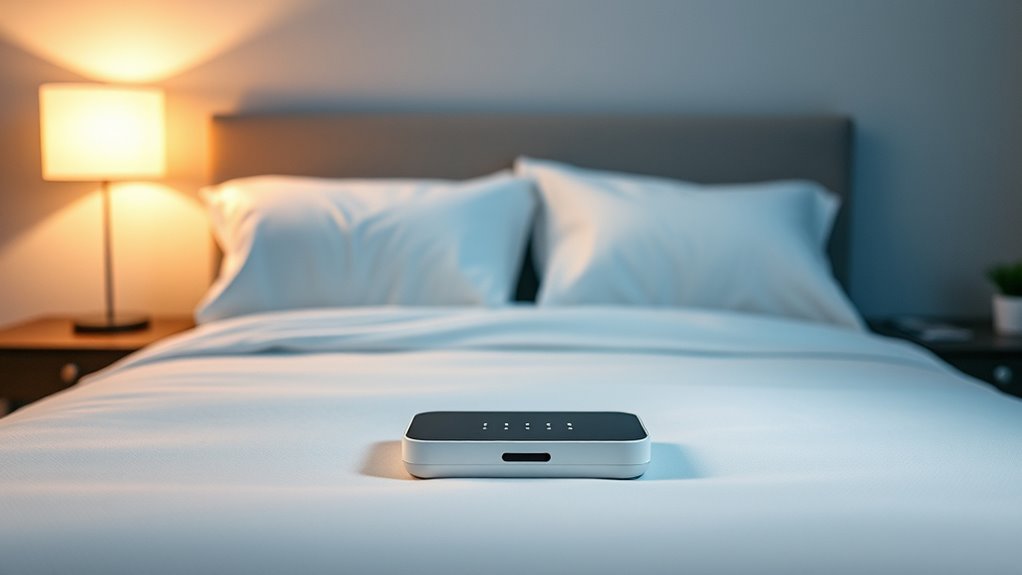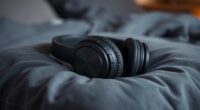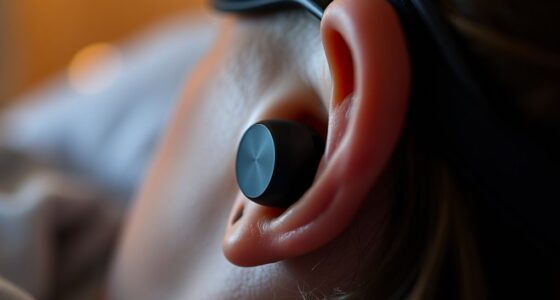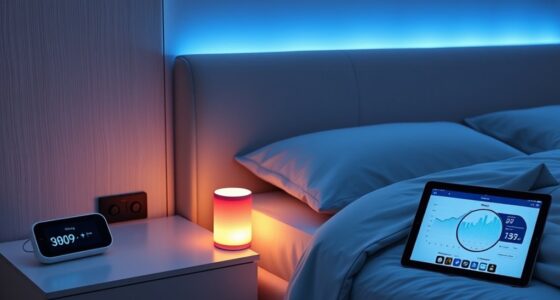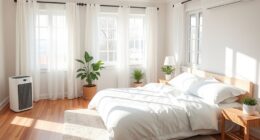Smart bed sensors detect sleep apnea by monitoring your breathing patterns, body movements, and heart rate throughout the night, all without interrupting your sleep. These sensors pick up subtle changes like irregular breathing pauses or disruptions, which are common in sleep apnea episodes. Their advanced technology guarantees highly accurate data, helping identify issues early. If you want to discover more about how this technology works and its benefits, keep exploring further.
Key Takeaways
- Smart bed sensors monitor breathing patterns and detect irregularities or pauses indicative of sleep apnea episodes.
- They use pressure, acoustic, and motion sensors to capture subtle changes in respiratory activity during sleep.
- Continuous data collection allows for pattern recognition and identification of breathing irregularities over time.
- Accurate sensor calibration ensures reliable detection of brief breathing disruptions characteristic of sleep apnea.
- The non-intrusive design maintains comfort, enabling natural sleep while providing precise monitoring for diagnosis.
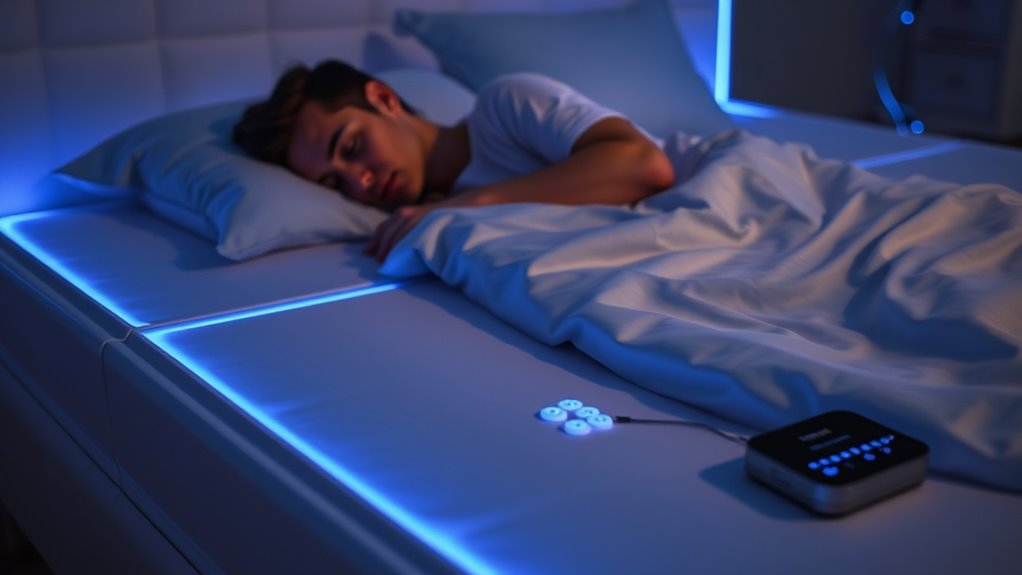
Sleep apnea often goes unnoticed because many people are unaware of how it affects their health. You might not realize that your disrupted sleep, daytime fatigue, or even morning headaches could be signs of this condition. Fortunately, smart bed sensors are changing the way sleep disorders are detected, providing a non-intrusive way to monitor your breathing patterns and movements throughout the night. These sensors are embedded in the mattress or bed frame, designed to track subtle physiological signals without requiring uncomfortable attachments or wearables. This approach makes it easier for you to get an accurate assessment of your sleep health without disrupting your nightly routine.
One of the most critical aspects of smart bed sensors is sensor accuracy. These sensors utilize advanced technologies like pressure sensors, accelerometers, and acoustic sensors to detect minute changes in your body’s movements, breathing, and heart rate. Because sleep apnea episodes often involve brief pauses in breathing or irregular breathing patterns, the sensors need to be highly precise to identify these episodes reliably. Manufacturers continually refine sensor calibration to ensure high fidelity in data collection, which means your sleep data is detailed and trustworthy. Accurate data enables healthcare providers to make better-informed diagnoses and treatment plans, potentially catching sleep apnea early before it leads to more serious health issues like hypertension or cardiovascular disease.
Furthermore, some smart bed sensors incorporate sleep monitoring features that allow users to review their sleep quality over time, helping them recognize patterns or triggers related to sleep disturbances.
Patient comfort is equally essential because no one wants to sleep soundly only to be awakened by uncomfortable or intrusive monitoring devices. Smart bed sensors are designed with this in mind, providing a seamless experience that doesn’t interfere with your sleep. You don’t have to wear bulky equipment or attach uncomfortable patches—your mattress or bed frame does all the work. The sensors are often thin, unobtrusive, and integrated into the bedding, ensuring you remain comfortable and relaxed. This focus on comfort encourages longer, more natural sleep cycles, which is crucial for accurate sleep analysis. When you’re comfortable, you’re more likely to sleep deeply, giving the sensors better opportunities to capture the data needed to detect sleep apnea.
Frequently Asked Questions
How Accurate Are Smart Bed Sensors Compared to Traditional Sleep Studies?
You might wonder about the accuracy of smart bed sensors versus traditional sleep studies. While they provide convenient insights into your sleep quality, their accuracy depends on proper sensor calibration and technology. Generally, smart sensors offer a good overview but may not match the detailed precision of clinical sleep studies. For routine tracking, they’re useful, but for a definitive diagnosis, a professional sleep study remains the gold standard.
Can Smart Bed Sensors Differentiate Between Sleep Apnea and Other Sleep Disorders?
Think of smart bed sensors as detectives in a sleep mystery. They use advanced sensor specificity to identify signs of sleep disorders, including sleep apnea. While they can often distinguish between sleep apnea and other issues like insomnia or restless leg syndrome, their accuracy isn’t perfect. They excel at sleep disorder differentiation but may need supplemental data for a definitive diagnosis. Always consult a healthcare professional for thorough evaluation.
What Are the Privacy Concerns Associated With Sleep Monitoring Data?
When it comes to sleep monitoring data, you might worry about privacy. Smart bed sensors collect sensitive information, so guarantee your data is protected through data encryption to prevent unauthorized access. Also, look for features that preserve user anonymity, so your personal details stay private. By choosing reputable brands with strong privacy policies, you can enjoy sleep insights without compromising your privacy or security.
How Do Smart Bed Sensors Handle False Positives or Negatives?
Imagine your sleep monitor is finely tuned to catch every breath, but sometimes it whispers false alarms or misses a beat. Smart bed sensors handle this by reducing false positives and negatives through regular sensor calibration, ensuring accuracy. When false alarms occur, they’re usually due to minor disturbances or calibration needs. Rest assured, these systems are designed to adapt, providing you reliable sleep tracking without unnecessary worry.
Are Smart Bed Sensors Suitable for All Age Groups and Health Conditions?
You might wonder if smart bed sensors suit everyone. Age considerations matter, as they’re often designed with adults in mind, and may not be ideal for young children or seniors with specific health conditions. For certain health conditions, like severe sleep disorders or respiratory issues, consult your doctor first. While these sensors work well for many, understanding their limitations guarantees you select the right monitoring method for your age and health needs.
Conclusion
With smart bed sensors, you hold the key to revealing your sleep’s hidden secrets. These tiny guardians act like vigilant sentinels, quietly listening and watching as you drift into dreamland. They catch the whispers of sleep apnea, much like a detective uncovering clues in the night’s shadows. By embracing this technology, you transform your bed into a sanctuary of awareness, ensuring you wake up refreshed, knowing your nights are monitored by a silent, watchful protector.
